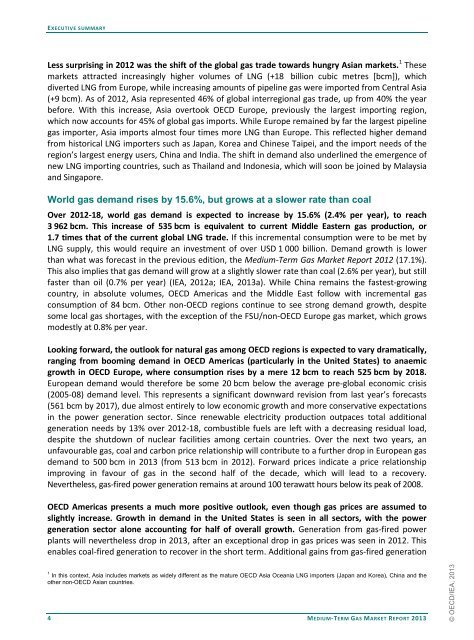Medium-Term Gas Market Report 2013 - IEA
Medium-Term Gas Market Report 2013 - IEA
Medium-Term Gas Market Report 2013 - IEA
You also want an ePaper? Increase the reach of your titles
YUMPU automatically turns print PDFs into web optimized ePapers that Google loves.
EXECUTIVE SUMMARY<br />
Less surprising in 2012 was the shift of the global gas trade towards hungry Asian markets. 1 These<br />
markets attracted increasingly higher volumes of LNG (+18 billion cubic metres [bcm]), which<br />
diverted LNG from Europe, while increasing amounts of pipeline gas were imported from Central Asia<br />
(+9 bcm). As of 2012, Asia represented 46% of global interregional gas trade, up from 40% the year<br />
before. With this increase, Asia overtook OECD Europe, previously the largest importing region,<br />
which now accounts for 45% of global gas imports. While Europe remained by far the largest pipeline<br />
gas importer, Asia imports almost four times more LNG than Europe. This reflected higher demand<br />
from historical LNG importers such as Japan, Korea and Chinese Taipei, and the import needs of the<br />
region’s largest energy users, China and India. The shift in demand also underlined the emergence of<br />
new LNG importing countries, such as Thailand and Indonesia, which will soon be joined by Malaysia<br />
and Singapore.<br />
World gas demand rises by 15.6%, but grows at a slower rate than coal<br />
Over 2012-18, world gas demand is expected to increase by 15.6% (2.4% per year), to reach<br />
3 962 bcm. This increase of 535 bcm is equivalent to current Middle Eastern gas production, or<br />
1.7 times that of the current global LNG trade. If this incremental consumption were to be met by<br />
LNG supply, this would require an investment of over USD 1 000 billion. Demand growth is lower<br />
than what was forecast in the previous edition, the <strong>Medium</strong>-<strong>Term</strong> <strong>Gas</strong> <strong>Market</strong> <strong>Report</strong> 2012 (17.1%).<br />
This also implies that gas demand will grow at a slightly slower rate than coal (2.6% per year), but still<br />
faster than oil (0.7% per year) (<strong>IEA</strong>, 2012a; <strong>IEA</strong>, <strong>2013</strong>a). While China remains the fastest-growing<br />
country, in absolute volumes, OECD Americas and the Middle East follow with incremental gas<br />
consumption of 84 bcm. Other non-OECD regions continue to see strong demand growth, despite<br />
some local gas shortages, with the exception of the FSU/non-OECD Europe gas market, which grows<br />
modestly at 0.8% per year.<br />
Looking forward, the outlook for natural gas among OECD regions is expected to vary dramatically,<br />
ranging from booming demand in OECD Americas (particularly in the United States) to anaemic<br />
growth in OECD Europe, where consumption rises by a mere 12 bcm to reach 525 bcm by 2018.<br />
European demand would therefore be some 20 bcm below the average pre-global economic crisis<br />
(2005-08) demand level. This represents a significant downward revision from last year’s forecasts<br />
(561 bcm by 2017), due almost entirely to low economic growth and more conservative expectations<br />
in the power generation sector. Since renewable electricity production outpaces total additional<br />
generation needs by 13% over 2012-18, combustible fuels are left with a decreasing residual load,<br />
despite the shutdown of nuclear facilities among certain countries. Over the next two years, an<br />
unfavourable gas, coal and carbon price relationship will contribute to a further drop in European gas<br />
demand to 500 bcm in <strong>2013</strong> (from 513 bcm in 2012). Forward prices indicate a price relationship<br />
improving in favour of gas in the second half of the decade, which will lead to a recovery.<br />
Nevertheless, gas-fired power generation remains at around 100 terawatt hours below its peak of 2008.<br />
OECD Americas presents a much more positive outlook, even though gas prices are assumed to<br />
slightly increase. Growth in demand in the United States is seen in all sectors, with the power<br />
generation sector alone accounting for half of overall growth. Generation from gas-fired power<br />
plants will nevertheless drop in <strong>2013</strong>, after an exceptional drop in gas prices was seen in 2012. This<br />
enables coal-fired generation to recover in the short term. Additional gains from gas-fired generation<br />
1 In this context, Asia includes markets as widely different as the mature OECD Asia Oceania LNG importers (Japan and Korea), China and the<br />
other non-OECD Asian countries.<br />
4 MEDIUM-TERM GAS MARKET REPORT <strong>2013</strong><br />
© OECD/<strong>IEA</strong>, <strong>2013</strong>

















